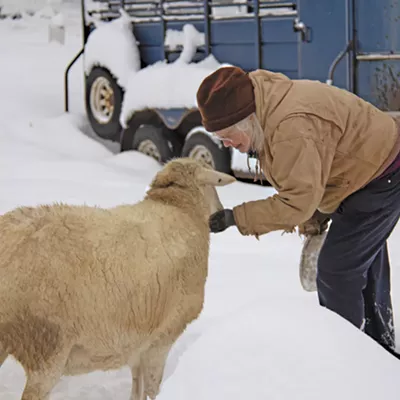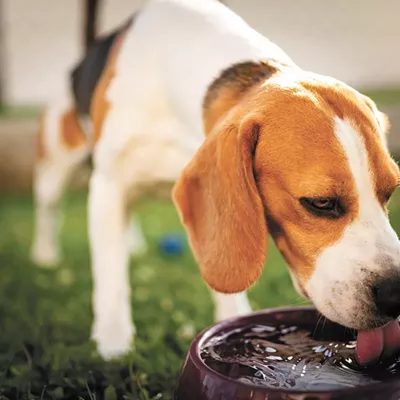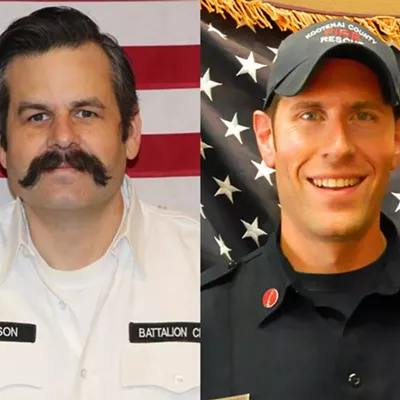The black cat lets out an urgent meow as visitors enter the room. Two other animals in adjacent cages lie dead, their bodies deflated after an injection of sodium pentobarbital.
This one is next in line to be euthanized -- killed by a lethal dose of the barbiturate and stored in a walk-in freezer until the next time the incinerator is turned on. Many more will follow.
The grim process of euthanasia has become daily routine at Spokane's three animal shelters. Indeed, last year alone, 8,917 animals were put to death, according to animal control officials. That means 24 animals were killed each day, one for every hour in the year.
While experts believe pet overpopulation is improving on a national scale, the Inland Northwest continues to lag behind.
"The fact is we're still killing lots of animals each week," says Nancy Hill, director of Spokane County Regional Animal Care and Protection Services (SCRAPS), which operates the county's shelter located in Spokane Valley.
After 17 years with the animal control agency, and eight as its director, Hill decided the warm-and-fuzzy pleas to license your pets and have them fixed had been ineffective. The population of unwanted and abandoned animals continues to rise, especially in the numbers of cats entering the shelter.
In 1996, there were 1,944. Last year, 3,841.
"We were going on at status quo, and we weren't getting anywhere," Hill says. "We've been acting as a Band-Aid."
So two years ago, after learning of a successful zero-tolerance program in Calgary, which demanded owners license their pets by a deadline or face hefty fines, Hill set out to find a message that might stir Spokane to act. She suspected that Canadians, being Canadians, were moved by different appeals.
Using donation money, SCRAPS hired a marketing company, which in turn convened a research group. It concluded that people here were motivated less by threats of big fines than, as Hill says, "more compassionate reasons." Two messages seemed to have traction: that licensing would help your lost pet be returned and that licensing revenues could help bring an end to euthanasia.
With this inside information, SCRAPS put together two corresponding advertisements, which began appearing Oct. 8 on television and radio. One tells the story of a woman reunited with her golden retriever through license records; the other shows a series of black-and-white photographs of healthy, adoptable pets that had to be killed in August because of overpopulation. Both end with the punch line, "License your pet. Prove that you care."
(Through the end of November, the city and county will forgive late fees to owners who license their pets.)
It's too early to know whether the public awareness campaign will have any lasting effect, Hill says. The ads, which stopped running at the end of October, will appear again in January. Most feedback from the public has been positive, but the shelter received letters from two people who thought the ad showing pictures of doomed pets was too gruesome.
"Some of this is shock therapy," Hill acknowledges.
Adoptions Down
Changing the habits of local pet owners takes extra creativity, in part because of the region's geography. With surrounding farmland, a rural attitude toward pets -- that they are commodities -- continues to persist in some corners, shelter operators say.
Similarly, other misconceptions are hard to shake, like the belief that unaltered dogs make better watchdogs or that female cats become calmer after having a litter.
But perhaps the most persuasive factor in the local fight against pet overpopulation is Spokane's struggling economy, experts believe. Money is tight, and pets are often looked upon as luxury expenditures.
"Sometimes it's a matter of getting shoes for the kids or getting their puppies fixed," says Diane Rasmussen, education and volunteer director at the Spokane Humane Society, which operates a nonprofit shelter supported by local donations. Its focus is adopting owner-relinquished pets, rather than strays, and thus retains some control over which pets come through the front door.
Rasmussen adds that, despite the misperception to the contrary, the Humane Society does euthanize animals, often induced to do so because of space limitations. Over the past decade, the shelter's intake had been slowly declining, but it recently began to plateau and now appears to be increasing again. More alarming, however, is the fact that adoption numbers have dropped this year. "That's something you never want to see go down," she says.
Similar frustrations are occurring at SpokAnimal CARE, which handles the city of Spokane's animal control duties and runs its shelter. On a recent morning, Alex Barrow, director of operations, walked along an aisle of occupied cages.
"Stray, stray, stray," he said, pointing out three adjacent pens. "You get the idea."
The number of animals coming through the SpokAnimal facility, however, peaked in 1999 at 10,000, but has dropped recently to about 8,500, according to SpokAnimal Director Gail Mackie. She credits the delayed effects of spay/neuter programs.
Nationally, pet overpopulation varies from region to region, but overall rates of euthanasia seem to be declining. While comprehensive statistics remain scarce, Merritt Clifton, editor of the Animal People newspaper, based in Clinton, Wash., has conducted a survey since 1993 of 51 percent of the country's shelters. Extrapolating from that data, Clifton found certain trends:
The number of euthanized animals per capita is lowest near the coasts and increases as you go further inland, where, in general, communities are poorer and more rural. Cities tend to do better. And those living in communities above the snowline have fewer animals to kill because of winter cold.
West Coast states currently kill about 14 pets per 1,000 people -- slightly better than the national average -- but that figure is misleading: Inland communities of the same states kill at the rate of 35.8, according to Clifton.
Nevertheless, he sees definite signs of improvement across the country. After piecing together old records, Clifton estimates shelter killing peaked at about 23.4 million in 1970. By 1992, it dropped to 5.7 million and now is close to 4.2 million.
"No other country, developed or undeveloped, has gotten to killing as many animals as the U.S.," Clifton says. "Over the last 30 years, though, we've got dramatically better."
Multiplier Effect
Local officials remain hopeful that current efforts will soon pay big dividends. Already, they say, opinions about owner's responsibilities seem to be changing. Education programs are helping. They point to their spay/neuter voucher programs, which subsidize an owner's cost of fixing an animal with money generated from licenses.
And with the Internet and sites like Petfinder.org, shelter operators have begun to communicate with agencies across the region. As a result, pets that would have been euthanized here in Spokane can be placed in communities that want them.
Animal advocates warn, however, that until more owners sterilize their pets, adoption can't solve the problem. That's because there will never be enough homes -- unaltered animals reproduce too fast. In six years, a female dog and her offspring can produce 67,000 dogs; in seven years, a female cat and her offspring can generate 420,000 cats.
As it is, an animal's journey through the local shelter system is rapid. By law, a pet that can be identified through a license or embedded microchip must be held for five days. (Owners only reclaim about 34 percent of dogs and 3 percent of cats at the county facility.) But considering that many are strays, very few animals are able to stay in the shelter longer than two weeks.
"To work in this job, you have to be a realist," says Hill, the director of SCRAPS. "You have to be able to let go. It's the only way you can survive."
Mary Paullin, who has worked at the county's animal shelter for eight years, worries that when she gets old, she'll walk around mumbling and incessantly washing her hands. She feels guilty; she has put countless animals to death. Every time she euthanizes another feral cat, she wants to cry. Even talking about it brings tears.
"You take these innocent animals who never had a chance in the world and you kill them," she says. "You squeeze them into a little box and hold it tight and put a needle into them.
"They look up at you and their eyes get about this big," Paullin says, making a circle with her index finger and thumb. "It breaks your heart."
To learn more about pet adoption or spay/neuter programs, call: Spokane Humane Society, 467-5235; Spokanimal Care, 534-8133; Spokane County Regional Animal Care and Protection Services (SCRAPS), 477-2532. Or check out www.spokanepet.net.



















